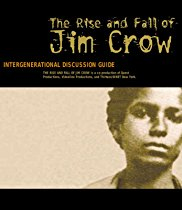The Rise and Fall of Jim Crow
Programs 1 & 2 - April 18 <Read More>
Programs 3 & 4 - April 25
The Rise and Fall of Jim Crow offers the first comprehensive look at race relations in America between the Civil War and the Civil Rights Movement. This definitive four-part series documents a brutal and oppressive era rooted in the growing refusal of many Southern states to grant slaves freed in the Civil War equal rights with whites. A life of crushing limitation for Southern Blacks, defined by legal segregation known as "Jim Crow" - after a minstrel routine in which whites painted their faces black - shaped the social, political and legal history of the period. In 1954, with the Supreme Court decision in Brown vs. Board of Education, the Jim Crow laws and way of life began to fall.
The story of the struggle during Jim Crow is told through the eyes of those who experienced it. Some are historical figures such as W.E.B. Du Bois, Booker T. Washington, Ida B. Wells and Walter White. Others are everyday local heroes like William Holtzclaw, Charlotte Hawkins Brown, Ned Cobb, "Pap" Singleton and Barbara Johns.
These screenings are cosponsored by Antaeus Theatre for its production of Nambi Kelley’s play Native son (based on the novel by Richard Wright).

Program Three: Don't Shout Too Soon (1917 - 1940) (2002; 56 min)
Written, Produced and Directed by Bill Jersey
In the aftermath of World War I a new round of race riots and lynching broke out, yet this was also a time of increasing strength for Black resistance movements. Episode three chronicles the years between the wars as a time of massive Black migration out of the South and continuing conflict within it. By the 1930's many African-Americans found their sole support from Socialists and Communists, who helped organize tenant farmers and sharecroppers and defended the "Scottsboro Boys," nine Black youths falsely accused of rape. While NAACP counsel Charles Houston began a lengthy legal campaign designed to chip away at Jim Crow, Walter White waged war in the court of public opinion. As the world plunged toward World War II, Black labor leaders like A. Philip Randolph demanded an end to segregation in defense industries. Singer, actor and activist Paul Robeson declared that, "Change is in the air."
 Program Four: Terror and Triumph (1940 - 1954) (2002; 56 min)
Program Four: Terror and Triumph (1940 - 1954) (2002; 56 min)
Written and Directed by Bill Jersey and Richard Wormser; Produced by Richard Wormser, Bill Jersey and Sam Pollard
Episode four examines the surge of Black activism that took place after World War II. Black veterans returned from the war determined to achieve the same rights at home that they had fought for in Europe in a Jim Crow army. One vet, Medgar Evers, became an organizer for the Mississippi NAACP; he was assassinated for his work in 1963. In Georgia, John Wesley Dobbs, head of the Black Masons, organized the first voter-registration drives. Predictably, whites again answered Black demands for equality with violence. But this time, President Truman responded with a civil rights initiative and integrated the Army. Southern Democrats split from the Democratic Party forming the States Rights Party.
But slowly the national mood was changing. Barriers fell in sports and entertainment. Here, for the first time on film, those who had been high school students in Farmville, VA reconstruct their historic walk-out and protest against segregated and inadequate education. They galvanized the community to join in an NAACP lawsuit that was combined with four other NAACP suits across the country to become Brown v. Board of Education. The landmark Brown decision irreparably breached the legal basis for Jim Crow, and through that opening soon poured the legions of the Civil Rights Movement.